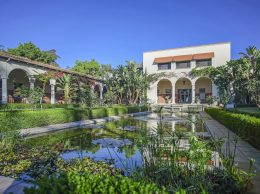UCSB forecast predicts ‘new normal’ for water conservation
IN THIS ARTICLE
- Central Coast Topic
- Marissa Nall Author
By Marissa Nall Friday, January 27th, 2017
A mid-year forecast by the UC Santa Barbara Economic Forecast Project illustrated a “new normal” for water conservation measures but uncertainty for the economy in the wake of the election.
Demand has fallen below 10,000 acre feet of water for the Goleta Water District after mandated conservation requirements. While not sustainable in the long term, water use levels won’t return to their previous heights when the restrictions are lifted, said John McInnes, general manager for the Goleta Water District.
“That speaks to the community’s ability for extraordinary conservation,” McInnes said. “We don’t believe 10,000 is sustainable but I think after this drought is over that there will be a new normal for the community. People have made decisions and a permanent change in their lifestyle.”
The district anticipates a 24 percent deficiency for the year and 38 percent over two years, so it will maintain a stage three emergency to manage demand, McInnes said.
Multi-family residential and commercial users have brought consumption close to the minimum public health and safety threshold, while single family residential, agriculture and landscape irrigation have more leeway.
“However, we recognize that further reductions in these sectors would likely have significant detrimental effects, both on the customers and the community at large, so we hope we don’t have to go there,” McInnes said.
New development from entitlements granted before the 2014 moratorium have resulted in an additional 200 acre feet of demand annually, or around 1.5 percent of normal demand, adding 68,000 square feet of retail, 1,000 residential units and two hotels with around 250 rooms.
Population growth doesn’t necessitate increased water demand, said Joshua Haggmark, water resources manager for the city of Santa Barbara, but per-capita water need estimates made by the state don’t factor in around 5 million annual tourists.
Lake Cachuma began to receive inflow from the Gibraltar Reservoir Jan. 24, but would need another 50,000-100,000 acre feet of water before it would begin to benefit Cachuma project members, Haggmark said. The activation of the desalination plant at 525 E. Yanonali St. will begin to deliver around 3,000 acre feet of water in March or April, with the option to increase production to around 10,000 acre feet annually.
“It’s all about diversifying our portfolio and I think putting too many eggs in the desal basket certainly has economic impact on people’s water rates, so it’s all about finding that balance,” Haggmark said.
Meanwhile, uncertainty around issues ranging from financial regulation and international trade to tax reform, health care and immigration have left other industries feeling wary, despite generally positive economic indicators, said Peter Rupert, executive director of the Economic Forecast Project.
“There’s so much uncertainty out there,” Rupert said. “People have already pulled back a bit on some of the things they’re doing.”
Federal Reserve economists are forecasting a return to normal interest rates, while home prices, debt to net worth ratios and the percentage of homes with negative equity have moderated.
• Contact Marissa Nall at [email protected].












